Archive for the 'Fruit' Category
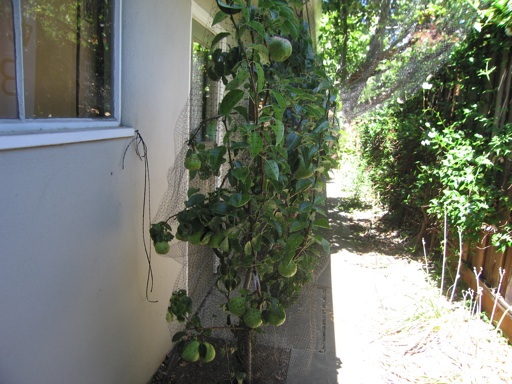
When I first moved into the house I live in, there was a small tree growing near the side door of the garage, crammed into a 2-foot strip between the house and a concrete pathway. The tree produced large fuzzy yellow fruits in the fall that resembled apples. I eventually discovered that the fuzzy yellow fruits were quinces. It turns out quinces are so sour they can’t be eaten fresh. They are mainly used to make jams and jellies.
In any event, I noticed some scrawny branches were growing from the bottom of the tree that had different looking leaves than the quince. I was able to identify those branches as pear branches, because there are two other pear trees on the property that had the same type of leaves. After doing some research, I figured out that the previous owners of the property had intended to plant a third pear tree, not a quince. It turns out that pear scions are often grafted onto quince rootstocks. However, rootstocks often grow suckers. If the suckers are not cut back, they can grow into a tree and eventually kill the scion.
After deciding we’d rather have another pear tree than a quince tree, we cut back the quince sucker to near where the pear scion was grafted onto it. That was about 3 or 4 years ago. Since then, the pear scion has grown considerably and produced pears. It bloomed during the quince years, but it never set any fruit. This year, it has produced about 20 pears (see above picture), which is impressive for such a small tree. The quince was a vigorous grower, so I think the tree developed a substantial root system prior to when we finally cut back the quince sucker.
A few years ago, I realized that this pear tree was producing two different looking types of pears. One type of pear was thinner in shape and ripened in August. It looked and tasted like a Bartlett pear. The other type of pear was fatter in shape, had a different color skin, and ripened much later. It looked and tasted like a Comice pear. So it turns out this tree is a multi-grafted pear tree. It was an interesting choice, because the two other pear trees on the property that were planted by the previous owners are a Bartlett and a Comice. Somebody really liked pears, which is fine with me because I really like them too. Most of the pears in this picture are Bartlett pears.
August 10 2012 | Pears | Comments Off on Multi-grafted Pear Tree
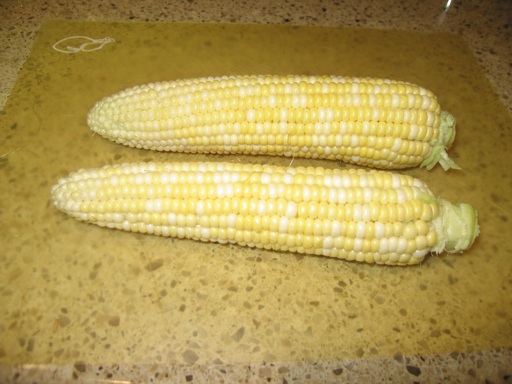
My partner and I ate corn on the cob from our vegetable garden for dinner tonight for the third night in a row. I harvested the corn just before dinner, shucked it, and then put it right into boiling water, so it didn’t have any time to lose flavor. We both thought they were some of the best tasting corn on the cobs we have ever eaten. They were sweet and very tender, unlike the tough and starchy ears of corn I have often bought from supermarkets.
My experience has been that the way to get the best tasting corn is to harvest it soon after the kernels have filled in and look matured (the way corn kernels are supposed to look). It helps to know when to expect your corn will be ready to harvest. I plant corn at the same time each year in late April, so that it is ready to harvest at the same time each year, starting around August 1. Also, corn tastes its best right after it has been harvested from the stalk. Corn seems to lose flavor when it is stored in the refrigerator for days after harvest.
The weather conditions also play a role in determining the sweetness of corn. Apparently, corn develops the most sweetness on sunny and relatively cool days. It’s mid-summer here, and everyday has been sunny after the morning fog burns off around 9 am. The daytime high temperatures have been mild, in the mid-70s to low 80s, for the past month.
August 03 2012 | Corn | Comments Off on Sweet and Tender Corn on the Cob
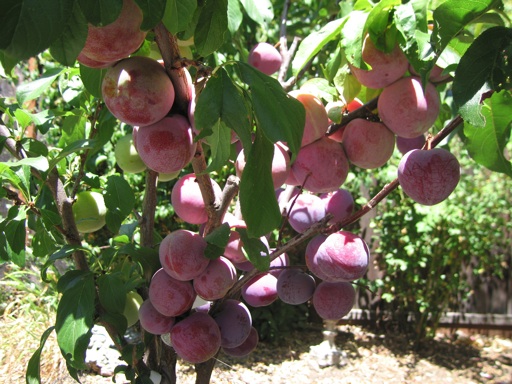
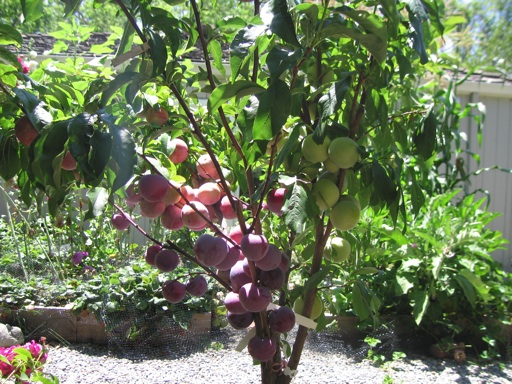
I planted this pluot tree in our yard three years ago. It has four pluot scions grafted onto one tree. The four pluot scions are Flavor King, Flavor Queen, Flavor Supreme, and Dapple Dandy. This summer, it’s producing its first significant crop of fruit. Pluots are plum/apricot hybrids. I don’t care for many of the common home orchard plum varieties, such as Santa Rosa and Beauty, because they are too tart for me. But so far, I am really impressed with how good home grown pluots taste.
I have already harvested all of the Flavor Supreme Pluots. They were very tasty. The fruits are sweet with a bit of tartness. They ripen early and are mostly greenish in color. However, I have noticed so far that among the four scions on our tree, Flavor Supreme is the least vigorous grower. Also, Flavor Supreme doesn’t set as many fruits as the other three scions (only 4 fruits this year).
Flavor King is the best tasting pluot of these four pluot varieties in my opinion. The fruit is sweet with a very inciting and unique flavor. It is already one of my favorite fruits. The fruits mostly ripen in August in our area and are deep purple when fully ripe (near the bottom of the second picture). My mom has a single-grafted Flavor King pluot tree that is a few years older than mine, and the fruits from her tree are delicious. Flavor King seems to be a moderate grower that sets a moderate amount of fruit compared to the other three pluot varieties. My Flavor King scion set about 20 pluots this year.
Dapple Dandy is another tasty pluot. The few Dapple Dandy fruits I’ve eaten off the tree so far were good, but a bit too tart. I think they need to stay on the tree until August to reach peak flavor. Dapple Dandy is a moderate grower, but it sets a lot of fruit. The small Dapple Dandy scion on my tree set over 50 pluots this year. I had to thin many of them to keep the branches from breaking off under the weight of the fruit. The pink fruits in the above pictures are the Dapple Dandy pluots.
Flavor Queen is the most vigorous grower of the four varieties I have. I’ve had to prune it three times this year to keep it from out growing the other varieties, even though the Flavor Queen scion is facing north. One of the hardest challenges with a multi-graft tree is keeping the scions balanced with each other. You need to keep pruning back the most vigorous scions throughout the growing season to keep them in balance with the less vigorous scions. If one scion outgrows the others, it might take over and overwhelm the other scions.
That’s essentially what has happened with my multi-grafted plum tree. The Beauty scion grew very large, and I didn’t prune it enough early on. Two of the less vigorous scions (Laroda and Nubiana) are small and stunted and don’t produce many plums. I haven’t tasted the fruit of Flavor Queen yet. It set about a dozen fruits this year, but they are still green and hard.
July 28 2012 | Pluots | Comments Off on Multi-grafted Pluot Tree
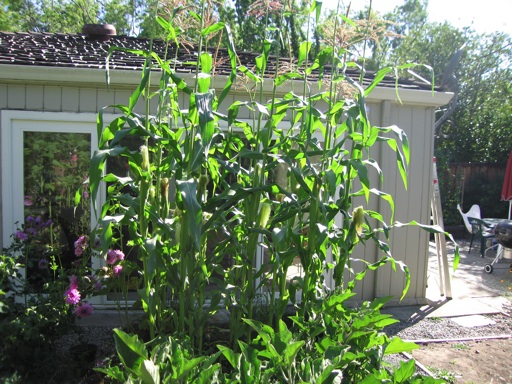
Corn is one of the most enjoyable plants to grow in a vegetable garden, because it grows so rapidly. Just a month ago, our corn plants were about one-third of their current height. Just in the past few weeks, each of the corn stalks has pushed out two ears of corn. The silk on some of them is starting to dry up already, which is often a sign that the ears are ready to pick. I haven’t picked any of the ears yet from this year’s crop, but I peeled back the husk on one of the ears that has dried silk, and it still had immature looking kernels. Pulling back the silk seems to be the only way to be sure that the ears are ready. Although this gardening site offers some interesting suggestions on other ways to tell when corn is ready to harvest.
This year, I am growing bicolored peaches and cream sweet corn that I planted by seed in late April. I planted seeds from the same variety of corn last year. The corn ears I picked initially around the 1st of August last year were very tasty and tender. However, we didn’t want to eat all of the corn at once, so I picked the remaining ears throughout the month of August. By mid-to-late August, the corn ears I was harvesting were more tough and less sweet. Harvesting corn as soon as it is ready and eating it right way seems to be the key to getting the best tasting corn. Corn seems to lose flavor when it’s left on the stalk and when it is stored in the refrigerator.
July 21 2012 | Corn | Comments Off on Corn nearly ready
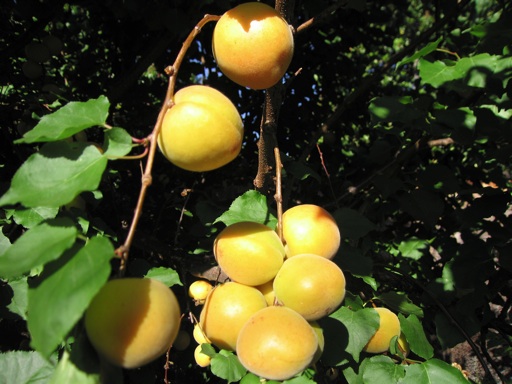
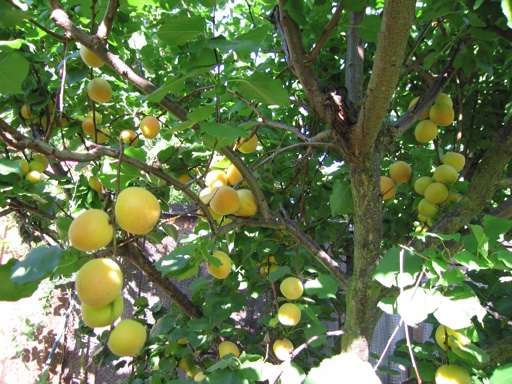
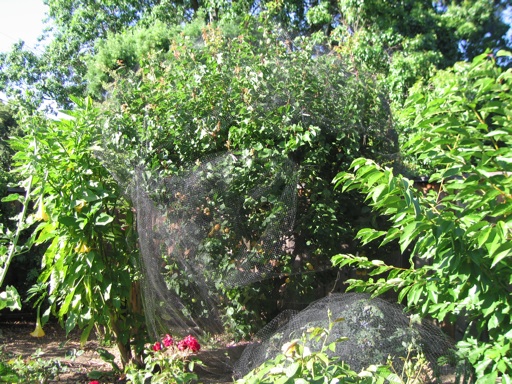
This season, our 10 year old Blenheim apricot tree has produced hundreds of apricots. It’s the same Blenheim apricot tree I blogged about in prior posts. The layers of netting wrapped around the sides, top and bottom of the tree kept out most of the critters. However, earwigs have gotten into several of them. Last weekend, I put a cardboard strip with tanglefoot around the trunk of the tree to deter the bugs from crawling up the tree at night. It seems to have helped.
I have already picked about half of the crop, and there is still over 100 unripe fruit left on the tree. Our home grown apricots are delicious as fresh fruit. But my favorite way to eat them is in an apricot crisp. Apricot crisp is a baked dessert of apricots and sugar covered with a butter crumble topping. It’s the best fruit pie in my opinion, the perfect balance of sweet and tart.
Last year, our apricot tree didn’t produce a single fruit, which I blame on the heavy rains that occurred during its bloom time. Heavy rains can damage apricot blossoms. Last March, forecasters predicted heavy rains again while our tree was in full bloom. So I covered the tree with a plastic sheet to protect the blossoms from damage. I have a picture of it covered in plastic in an earlier post on this blog. It seems to have worked.
After 10 years, this tree is in its prime. It grows very rapidly. It would grow about 4-6 feet or more per year in all directions if it weren’t for the fact that I prune it about 3 times a year. Typically, I prune once in January, once in early June just before netting it, and again in July or August after the fruit comes off. Keeping it a reasonable size makes the tree so much easier to net and to harvest the fruit. Between the pruning, netting, fertilizing, and picking, apricot trees (and fruit trees in general) can be a lot of work. But I enjoy the process, and I certainly enjoy the harvest.
July 07 2012 | Apricots | Comments Off on Apricots
« Prev - Next »







